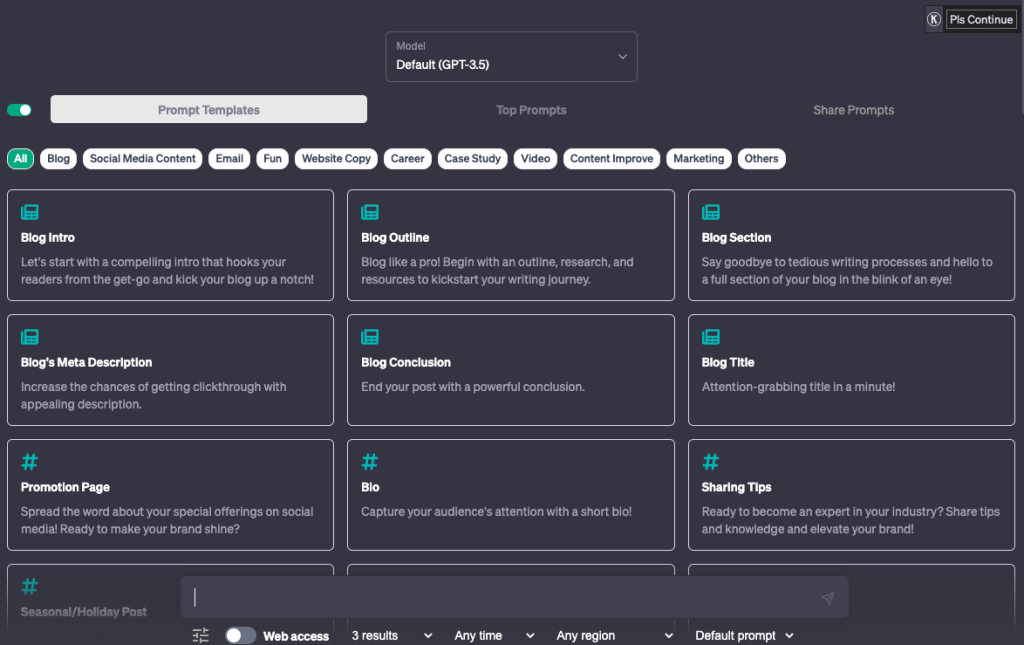Unlock the full potential of ChatGPT with our essential guide! Discover the six keys to success, including defining success criteria, crafting engaging prompts, and breaking down goals into manageable steps. Experiment with ChatGPT settings to tailor AI-generated content to your needs, and stay up-to-date on the latest developments in this rapidly evolving field. Don’t miss out on harnessing the power of AI to achieve your objectives—dive into our comprehensive guide now and get ready to revolutionise your ChatGPT experience!
- Establish a Clear Objective
- Define Success Criteria
- Use Clear and Precise Language
- Write an Engaging Prompt
- 60 Best Prompts to Save Yourself Time and Be More Productive:
- Develop a Systematic Process
- Continuously Iterate and Refine
- Supercharge your ChatGPT experience with these AI tools that enable you to browse the internet:
- Summary:
Maximising the capabilities of ChatGPT for text generation, question-answering, and creative exploration can be a game-changer. However, if you’ve ever faced challenges in obtaining the desired results from ChatGPT, rest assured you’re not alone!
Unlocking the full potential of ChatGPT goes beyond merely crafting the perfect prompt—it entails mastering six crucial aspects.
Let’s delve into these six essential steps to success and additional bonus tips for enhancing your ChatGPT experience:

Establish a Clear Objective
Before you begin, identify your specific goal, be it generating creative content, finding answers to questions, or exploring other possibilities. A well-defined objective will provide a strong foundation for your interactions with ChatGPT.
Define Success Criteria
Understand what success looks like for your objective by creating a clear vision of quality in that context. Familiarise yourself with successful examples to better assess ChatGPT’s responses and align them with your desired results.
To define success criteria for your ChatGPT interactions, you’ll need to establish a set of standards or benchmarks that will help you evaluate the AI’s performance in relation to your specific objectives. This process involves:
- Understanding your objective: Clearly identify your goal, such as generating creative content, answering questions, or any other purpose you want to achieve with ChatGPT.
- Creating a clear vision of quality: Determine the characteristics of a successful output in the context of your objective. For instance, if your goal is to generate engaging marketing copy, success criteria might include readability, persuasiveness, and relevance to the target audience.
- Identifying successful examples: Research and gather examples of high-quality outputs that match your success criteria. These examples can serve as a reference point for assessing ChatGPT’s responses. For instance, you could collect well-written articles, blog posts, or ad copies that exemplify the quality you aim to achieve.
- Assessing ChatGPT’s responses: Use your success criteria and collected examples to evaluate the AI’s outputs. Compare its responses to the quality benchmarks you’ve established. If ChatGPT’s responses don’t meet your standards, refine your prompts, guidelines, or feedback to improve the results.
- Aligning AI-generated content with desired results: Continuously assess and adjust your interactions with ChatGPT, ensuring that its outputs are in line with your predefined success criteria. This iterative process will help you obtain results that match your expectations and satisfy your requirements.
Use Clear and Precise Language
Effective communication is vital. Employ clear and accurate language to convey your goals and provide feedback. The better you communicate with ChatGPT, the more relevant and useful its responses will be. If necessary, consider using explicit constraints or guidelines to direct the AI’s output.
Write an Engaging Prompt
Once prepared, create an engaging and clear prompt to guide the AI in the desired direction. Concise and specific prompts set the stage for successful interactions with ChatGPT. Experiment with different phrasings or approaches to discover what works best for your unique requirements.
Here are some examples based on different objectives:
- Creative Writing:
- Objective: Generate a short story about a time-traveling detective.
- Engaging Prompt: “Write a 500-word short story about a detective who discovers a time-traveling device, using it to solve a mysterious case that spans across different time periods.”
- Marketing Copy:
- Objective: Create a product description for a new smartphone.
- Engaging Prompt: “Write a compelling 150-word product description for the ‘XYZ Smartphone,’ highlighting its sleek design, powerful performance, long battery life, and advanced camera features.”
- Educational Content:
- Objective: Explain the process of photosynthesis in simple terms.
- Engaging Prompt: “Provide a clear and easy-to-understand explanation of photosynthesis for a middle school audience, focusing on the role of sunlight, water, and carbon dioxide in producing glucose and oxygen.”
- Technical Writing:
- Objective: Write a step-by-step guide on how to set up a Wi-Fi router.
- Engaging Prompt: “Create a beginner-friendly, step-by-step guide on setting up a Wi-Fi router, including unboxing, connecting cables, configuring settings, and troubleshooting common issues.”
- Conversation Starter:
- Objective: Engage in a thought-provoking discussion about the future of artificial intelligence.
- Engaging Prompt: “As an AI language model, what are your thoughts on the potential benefits and drawbacks of artificial intelligence in the coming decades, and how do you envision it impacting society and our daily lives?”
If you tailor your prompt to your specific objectives and providing clear guidance, you will increase the chances of receiving the desired output from ChatGPT. Experiment with different phrasings and approaches to discover the most effective prompts for your unique requirements.
60 Best Prompts to Save Yourself Time and Be More Productive:
- Make copy more concise.
- Write attention-grabbing headlines.
- Create copywriting templates for common pieces.
- Brainstorm ways to engage readers in copy.
- Come up with three titles for a writing piece.
- Analyze copy effectiveness and make improvements.
- Write from customer perspective in copy.
- Develop persuasive argument for product/service.
- Rewrite copy to make it more persuasive.
- Analyze grammar and punctuation in copy.
- Research target audience for copy.
- Write copy in two different styles.
- Create easy-to-understand copy.
- Rewrite copy to make it more accessible.
- Develop style guide for specific copy type.
- Analyze successful copy and what makes it work.
- Rewrite copy for different audiences.
- Brainstorm ideas for blog post series.
- Rewrite copy to be more SEO-friendly.
- Analyze copy structure and make improvements.
- Research competition and write comparison.
- Write copy that addresses common objections.
- Rewrite copy to make it more conversational.
- Develop elevator pitch for new product/service.
- Rewrite copy to be more personal/relatable.
- Write successful customer case study.
- Brainstorm email series ideas to engage customers.
- Write copy targeted for specific demographic.
- Develop voice and tone guide for copy type.
- Analyze persuasive techniques in copy.
- Rewrite copy to make it memorable.
- Brainstorm ideas for whitepaper.
- Rewrite copy to be more appealing to younger demographic.
- Analyze the tone of copy and improve.
- Research target audience and develop profile.
- Write copy promoting product benefits.
- Rewrite copy to be more accurate/factual.
- Develop effective call-to-action.
- Rewrite copy to be more engaging/entertaining.
- Write customer success case study.
- Brainstorm social media series ideas.
- Write copy targeted for specific region/country.
- Develop style guide for copy consistency.
- Rewrite copy to be more convincing.
- Write attention-grabbing headlines.
- Develop persuasive copy template.
- Brainstorm ways to make copy more concise.
- Rewrite copy to be more informative.
- Write catchy headlines.
- Analyze copy structure and improve.
- Research target audience and write for them.
- Write persuasive and convincing copy.
- Rewrite copy to be more compelling.
- Analyze grammar and punctuation in copy.
- Research competition and create comparison.
- Rewrite copy to be more engaging.
- Write easy-to-read copy.
- Develop style guide for copy type.
- Rewrite copy to be more conversational.
- Rewrite copy to be concise and to the point.
Develop a Systematic Process
Breaking down your goal into manageable steps and understanding the process involves creating a structured approach to achieving your objective. This approach allows you to monitor progress, make adjustments, and tackle challenges effectively.
Here’s a more detailed explanation of this process:
- Identify your objective: Clearly define your overarching goal, such as creating engaging content, improving customer support, or generating sales copy.
- Break down the goal: Divide your main objective into smaller, achievable tasks or milestones. These smaller tasks will make it easier to track progress and identify potential challenges. For example, if your goal is to create engaging content, tasks could include brainstorming ideas, outlining the structure, writing a draft, editing, and publishing.
- Create a timeline: Assign a realistic time frame for completing each task or milestone. This helps you maintain momentum and ensures that you stay on track to achieve your objective.
- Establish checkpoints: Set up checkpoints or regular intervals at which you will evaluate your progress. This allows you to assess how well you are moving toward your goal, identify any roadblocks, and determine if adjustments are needed.
- Adapt and adjust: As you reach each checkpoint, review your progress and the effectiveness of your approach. If you find that you’re not making the expected progress or facing unexpected challenges, make any necessary adjustments to your strategy, timeline, or resources.
- Monitor and iterate: Continuously monitor your progress toward your goal, making refinements and adjustments as needed. Iterating on your approach helps ensure that you are always moving in the right direction and staying adaptable to changing circumstances.
Continuously Iterate and Refine
Make adjustments to your prompts, improve your feedback, and refine ChatGPT’s outputs. Embrace continuous improvement and learn from past interactions to optimize the AI’s performance. Don’t hesitate to seek insights or assistance from others, as collaboration can offer valuable perspectives and ideas.
Bonus Tips for an Enhanced ChatGPT Experience:
Experiment with the AI’s settings:
To experiment with ChatGPT settings, you can adjust various parameters that influence the AI’s output. These parameters include temperature, response length (max tokens), and other settings, depending on the platform or API you are using. Here’s a guide on how to experiment with ChatGPT settings:
- Temperature:
Temperature is a parameter that controls the randomness of the AI’s output. A higher temperature (e.g., 0.8 or 1.0) will result in more creative and diverse responses, while a lower temperature (e.g., 0.2 or 0.3) will produce more focused and deterministic outputs. You can experiment with different temperature settings to find the optimal balance between creativity and coherence for your specific use case.
- Response Length (Max Tokens):
The response length (measured in tokens) can be adjusted to control the length of the AI-generated output. By setting a limit on the maximum number of tokens in the response, you can ensure that the output is concise or detailed, depending on your requirements. Experiment with different response lengths to find the best fit for your objective.
- API Settings (For Developers):
If you’re using the OpenAI API to interact with ChatGPT, you can experiment with various parameters, such as n, which controls the number of responses generated for each prompt, and p, which filters the responses based on a probability threshold. You can also adjust the stop parameter to control when the AI should stop generating text. Check the API documentation for more details and examples.
- Platform-Specific Settings:
If you’re using ChatGPT on a specific platform, such as a chatbot builder or an AI writing tool, explore the available settings within that platform. These settings may include response time, AI model selection, or any platform-specific features designed to enhance the user experience.
- Iterate and Refine:
As you experiment with different settings, evaluate the results based on your success criteria and make adjustments accordingly. Continuously refine the settings and prompts to optimise the AI’s output for your specific requirements.
Stay up-to-date with ChatGPT developments:
As AI technology evolves, new features and improvements will become available. Stay informed about updates to make the most of your ChatGPT experience.
Here are some strategies to help you stay informed about the latest updates, features, and advancements:
- Follow OpenAI:
Subscribe to OpenAI’s official blog, newsletter, and social media channels to receive the latest news and announcements about ChatGPT and other AI models. These sources often provide updates on new releases, enhancements, and research developments.
OpenAI Blog: https://openai.com/blog/
OpenAI Newsletter: Subscribe through the OpenAI website.
Social Media: Follow OpenAI on Twitter (@OpenAI), LinkedIn, and other platforms.
- Engage in AI Communities:
Participate in online forums, communities, and social media groups focused on AI, ChatGPT, and related technologies. These platforms facilitate knowledge sharing, discussions, and updates among users and experts.
Reddit: Subreddits like r/MachineLearning, r/artificial, and r/OpenAI
AI and Chatbot Development Groups on LinkedIn and Facebook
- Read AI Publications:
Regularly read articles, research papers, and news from reputable AI-focused publications, websites, and researchers to stay informed about the latest advancements and trends in AI and natural language processing.
- Attend AI Events:
Participate in conferences, webinars, workshops, and meetups related to AI and ChatGPT. These events provide opportunities to learn from experts, network with other professionals, and discover the latest developments in the field.
- Experiment with AI Tools:
Stay proactive in exploring and experimenting with AI tools, including different versions of ChatGPT and other language models. Familiarize yourself with new features and improvements as they become available.
Want to know more AI tools? Check out the list below and come back as we will keep this list updated:
| Name | Category | Description |
| GPTZero | AI Detectors | Accurately detect AI plagiarism using multiple metrics. |
| GPTKit | AI Detectors | Detect ChatGPT generated text. |
| Deep Anime | Avatar Creation | Transform photos into anime scenes with just a tap. |
| OpenAI Text Classifier | AI Detectors | Predicts likelihood that a piece of text was generated by AI. |
| Replika | Chatbots | Chatbot companion that creates a unique and personal connection with the user. |
| CheckforAi | AI Detectors | Detect AI written text in essays, emails, and more. |
| Character.AI | Chatbots | Collaborate with a computer to seem like you are talking with another character. |
| Detect GPT | AI Detectors | Chrome extension that scans the content of pages as you browse the internet for AI. |
| GPT-Minus1 | AI Detectors | Fool GPT by randomly replacing words with synonyms in your text. |
| ChatGPT | Chatbots | Conversational search engine is designed to provide information through a chatbot-style. |
| ChatGPT for Search Engines | Chatbots | Chatbot extension that allows users to ask questions and receive human-like responses. |
| Jasper | Writing | Content platform that helps businesses create high-quality content faster. |
| Copy AI | Writing | Content generator that helps businesses and professionals create high-quality and engaging content. |
| Rytr | Writing | Writing assistant that helps you create high-quality content, in just a few seconds, at a fraction of the cost. |
| Tome | Writing | Helps you create compelling stories with any type of content. |
| GPT-3 Playground | Writing | Makes it easy to test prompts and get familiar with how the GPT-3 API works. |
| StockGPT | Finance | Tesla stock search tool that uses Tesla’s quarterly earnings call transcripts dating back to Q2 2011. |
| Genius Sheets | Finance | Analyze data from any of your organizations data sources using plain text. |
| Finalle.ai | Finance | Automagically analyze real-time financial intelligence. |
| Vocal Remover | Fun | Remove vocals from a song and create a karaoke version. |
| CoolAiid | Fun | Interior design ideas using AI, with over 20 styles to choose from and the ability to get inspiration for any room in the house. |
Provide context:
When crafting your prompt, offer context and background information to help the AI generate more accurate and relevant responses.
If you master these six steps, incorporate additional tips, and stay adaptable, you’ll not only unlock ChatGPT’s full potential but also elevate your experience to new heights. Remember, a great prompt is essential, but it’s only one component of a truly successful ChatGPT journey.
Supercharge your ChatGPT experience with these AI tools that enable you to browse the internet:
In addition to its impressive natural language processing capabilities, ChatGPT can be further enhanced with the help of powerful AI tools. Here are some of the top tools that can take your ChatGPT game to the next level:
- Merlin AI: A ChatGPT extension for any website that can provide website summaries, generate Twitter replies, and suggest content ideas.
- Hyperwrite AI: A personal assistant that lives in your browser and can perform tasks such as ordering pizza.
- Wiseone: An AI tool that simplifies online articles by summarizing them and providing accurate answers to questions.
- Glasp: A tool that provides quick summaries of YouTube videos by generating transcripts that can be summarized by ChatGPT.
- UseChatGPT AI: An AI writing assistant that can help users rewrite emails, change their writing tone, and create instant translations directly in their browser.
- ChatGPT for Google: A tool that integrates ChatGPT with Google search results, providing supercharged results to users.
Now you can streamline your online activities and take AI’s abilities to the next level.
Summary:
It involves a blend of thorough preparation, transparent communication, and ongoing refinement to master ChatGPT. Gaining insights into your objectives, devising captivating prompts, segmenting goals, adjusting settings, and keeping up with the newest advancements allows you to fully leverage ChatGPT to fulfil your specific requirements. Bear in mind, attaining success with AI is a continuous journey, and adaptability is crucial for unlocking its complete potential. Adopt these approaches and recommendations to revolutionise your ChatGPT experience and accomplish outstanding outcomes in your projects and pursuits.


